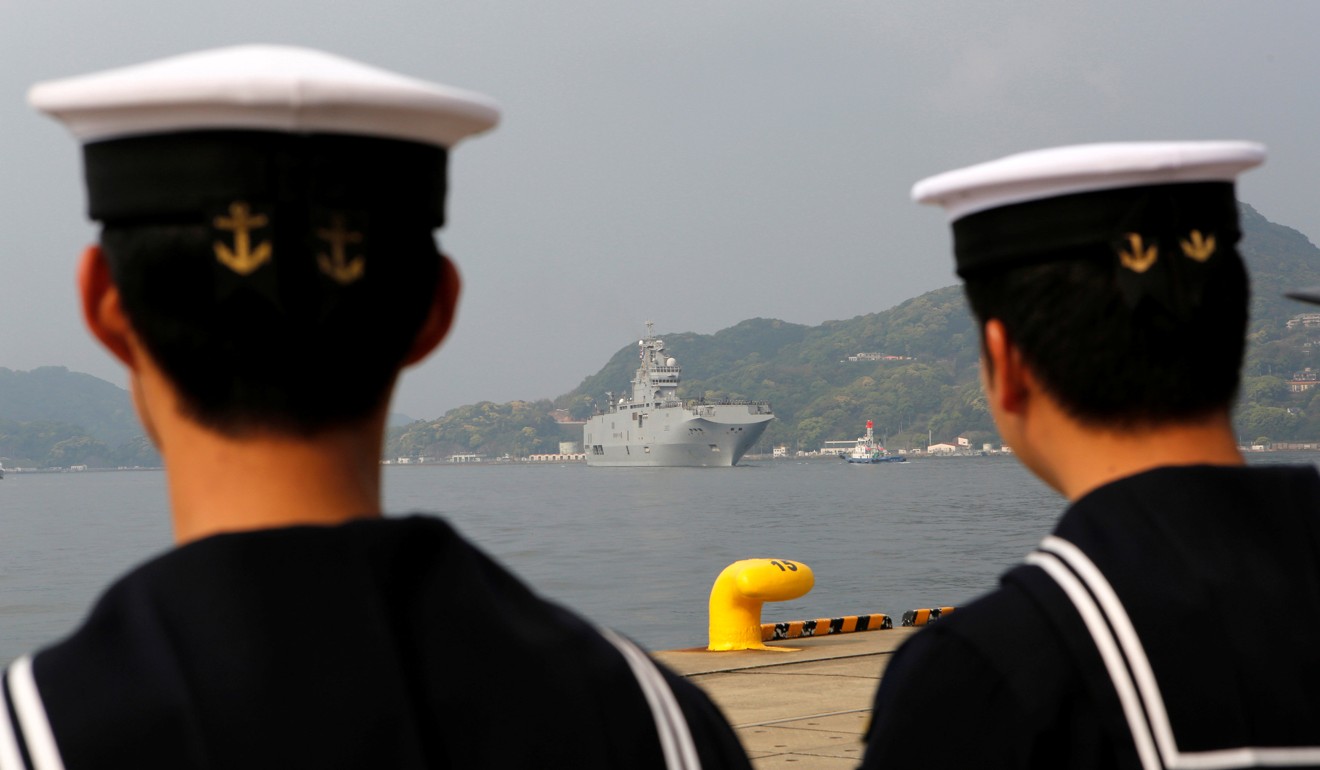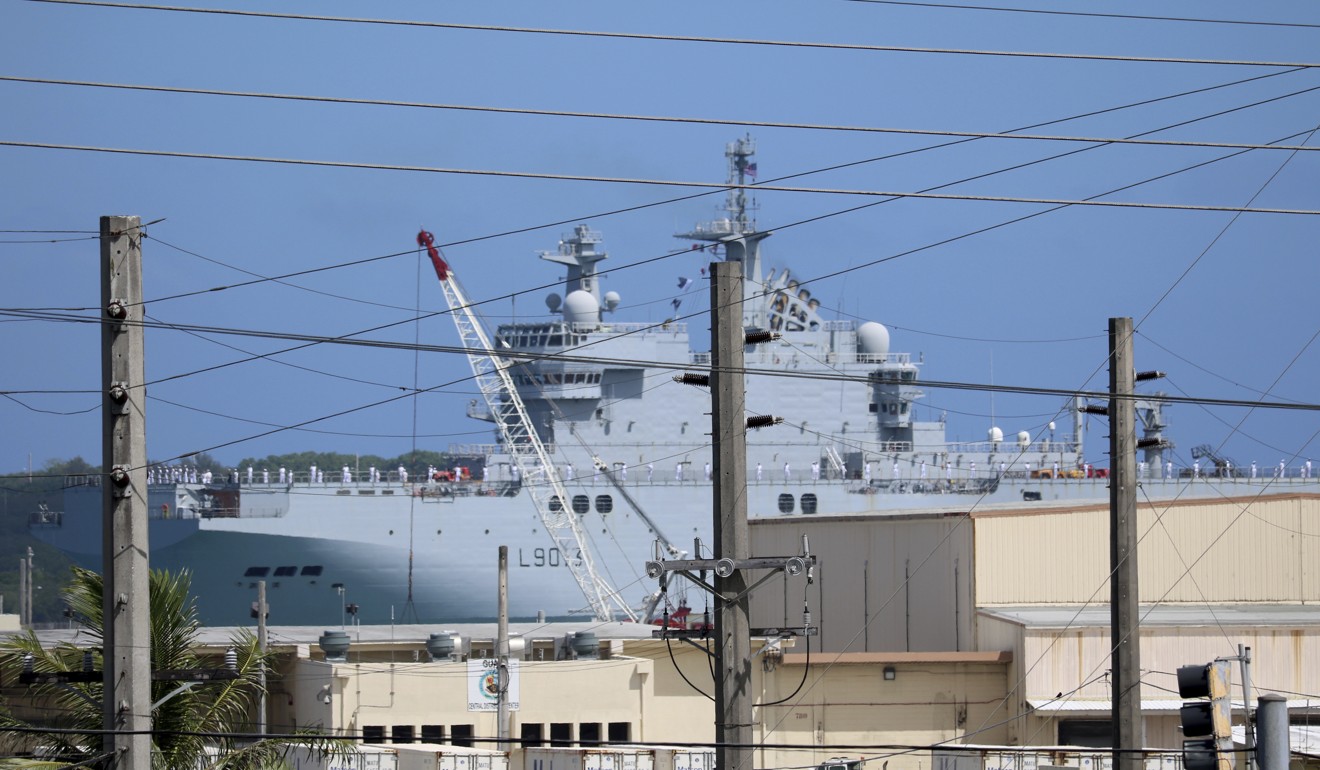
Multinational sea drill intended to send message to China postponed after French landing craft runs aground on Guam
The military exercise in Guam included US troops, British and Japanese helicopters and landing craft launched from France’s amphibious Mistral carrier
Multinational military drills on Guam designed to show support for the free passage of vessels in international waters amid concerns China may restrict access to the South China Sea have been indefinitely postponed after a French landing craft ran aground Friday.
US Navy Captain Jeff Grimes, chief of staff for Joint Region Marianas, said he didn’t know when the drills would resume.
“Currently we are working with our partners to include the Coast Guard, the Guam Environmental Protection Agency, the National Oceanographic and Atmospheric Administration and other federal and local agencies and stakeholders to further assess the situation,” Grimes said.
“Finally, I have directed that we stop all operations associated with this exercise until we conduct a further assessment of the situation as we gather all the facts.”
A French catamaran landing craft ran aground just offshore, said Jeff Landis, a spokesman for Naval Base Guam. The vessel didn’t hit coral or spill any fuel, he said. No one was injured. Friday’s landing was meant to be a rehearsal for a drill at Tinian island on Saturday, Landis said.

Two French ships on a four-month deployment to the Indian and Pacific oceans were to be featured in the drills.
Commanders did not name the type of vessel grounded. However the descriptions suggest it could have been a L-CAT fast amphibious landing catamaran.
The L-CAT can be deployed from the well deck of the French amphibious assault ship FS Mistral, which is in Guam for the exercise.
The Mistral is leading the Jeanne d’Arc amphibious task force in a tour through Asia. The French defence ministry, in summary of the mission, described it as “a potent support to French diplomacy”.
The Mistral, which left France in February, can carry up to 35 helicopters and four landing barges, as well as several hundred soldiers. The ship visited Japan this month before heading to Guam
Watch: French Navy L-CAT catamaran landing craft in action
The exercises involving the US, UK, France and Japan were expected to begin Friday and last a week.
The drills around Guam and Tinian islands were scheduled to include amphibious landings, delivering forces by helicopter and urban patrols.
Joining were Japanese forces, UK helicopters and 70 UK troops deployed with the FS Mistral. Parts of the exercise were to feature British helicopters taking US Marines ashore from a French vessel.

“The message we want to send is that we’re always ready to train and we’re always ready for the next crisis and humanitarian disaster wherever that may be,” US Marine Corps Lieutenant Col Kemper Jones, the commander of the 3rd Battalion, 8th Marine Regiment, said before the exercises were to begin. About 100 Marines from Jones’ unit were expected to be part of the drills slated for this weekend and next week.
China claims virtually the entire South China Sea and has aggressively tried to fortify its foothold in recent years by transforming seven mostly submerged reefs into island outposts, some with runways and radars and — more recently — weapons systems. The work is opposed by the other claimants to the atolls and the United States, which insists on freedom of navigation in international waters.

Western critics fear China’s actions could restrict movement in a key waterway for world trade and rich fishing grounds.
China says its island construction is mainly for civilian purposes, particularly to increase safety for ships. It has said it won’t interfere with freedom of navigation or overflight, although questions remain on whether that includes military ships and aircraft.
Mira Rapp-Hooper of the Centre for New American Security, a Washington think tank, said the exercises will send a strong message in support of a “rules-based order in Asia” at a time when China’s actions have raised questions about this.

“A reminder in this exercise is that lots of other countries besides the United States have an interest in that international order,” said Rapp-Hooper, who is a senior fellow with the center’s Asia-Pacific Security Programme.
The Guam exercises come amid modestly growing European interest in the South China Sea, said David Santoro, a senior fellow for nuclear policy at Pacific Forum CSIS, a Honolulu think tank.
“What I’m hearing from the French and to some degree the British, is an increased interest in what’s going on in Asia and how they can help,” Santoro said.
Japan, which sent 50 soldiers and 160 sailors and landing craft, has been investing in amphibious training so it can defend its own islands. Tokyo is concerned China might attempt to take over rocky, uninhabited outcrops in the East China Sea that Japan controls but Beijing claims. Japan calls the islands Senkaku while China calls them Diaoyu. Japan has also expressed an interest in vessels being able to freely transit the South China Sea.
Guam and Tinian are about 2,400 kilometres south of Tokyo. They’re about the same distance to the east from Manila, Philippines.
Additional reporting by Reuters

